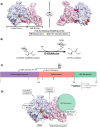Regulating the Regulators: Mechanisms of Substrate Selection of the O-GlcNAc Cycling Enzymes OGT and OGA
- PMID: 33498085
- PMCID: PMC8351506
- DOI: 10.1093/glycob/cwab005
Regulating the Regulators: Mechanisms of Substrate Selection of the O-GlcNAc Cycling Enzymes OGT and OGA
Abstract
Thousands of nuclear and cytosolic proteins are modified with a single β-N-acetylglucosamine on serine and threonine residues in mammals, a modification termed O-GlcNAc. This modification is essential for normal development and plays important roles in virtually all intracellular processes. Additionally, O-GlcNAc is involved in many disease states, including cancer, diabetes, and X-linked intellectual disability. Given the myriad of functions of the O-GlcNAc modification, it is therefore somewhat surprising that O-GlcNAc cycling is mediated by only two enzymes: the O-GlcNAc transferase (OGT), which adds O-GlcNAc, and the O-GlcNAcase (OGA), which removes it. A significant outstanding question in the O-GlcNAc field is how do only two enzymes mediate such an abundant and dynamic modification. In this review, we explore the current understanding of mechanisms for substrate selection for the O-GlcNAc cycling enzymes. These mechanisms include direct substrate interaction with specific domains of OGT or OGA, selection of interactors via partner proteins, posttranslational modification of OGT or OGA, nutrient sensing, and localization alteration. Altogether, current research paints a picture of an exquisitely regulated and complex system by which OGT and OGA select substrates. We also make recommendations for future work, toward the goal of identifying interaction mechanisms for specific substrates that may be able to be exploited for various research and medical treatment goals.
Keywords: O-GlcNAc; OGA; OGT; substrate selection.
© The Author(s) 2021. Published by Oxford University Press. All rights reserved. For permissions, please e-mail: journals.permissions@oup.com.
Figures


References
Publication types
MeSH terms
Substances
Grants and funding
LinkOut - more resources
Full Text Sources
Other Literature Sources
Miscellaneous

